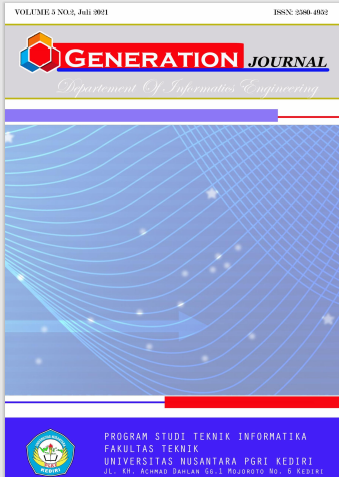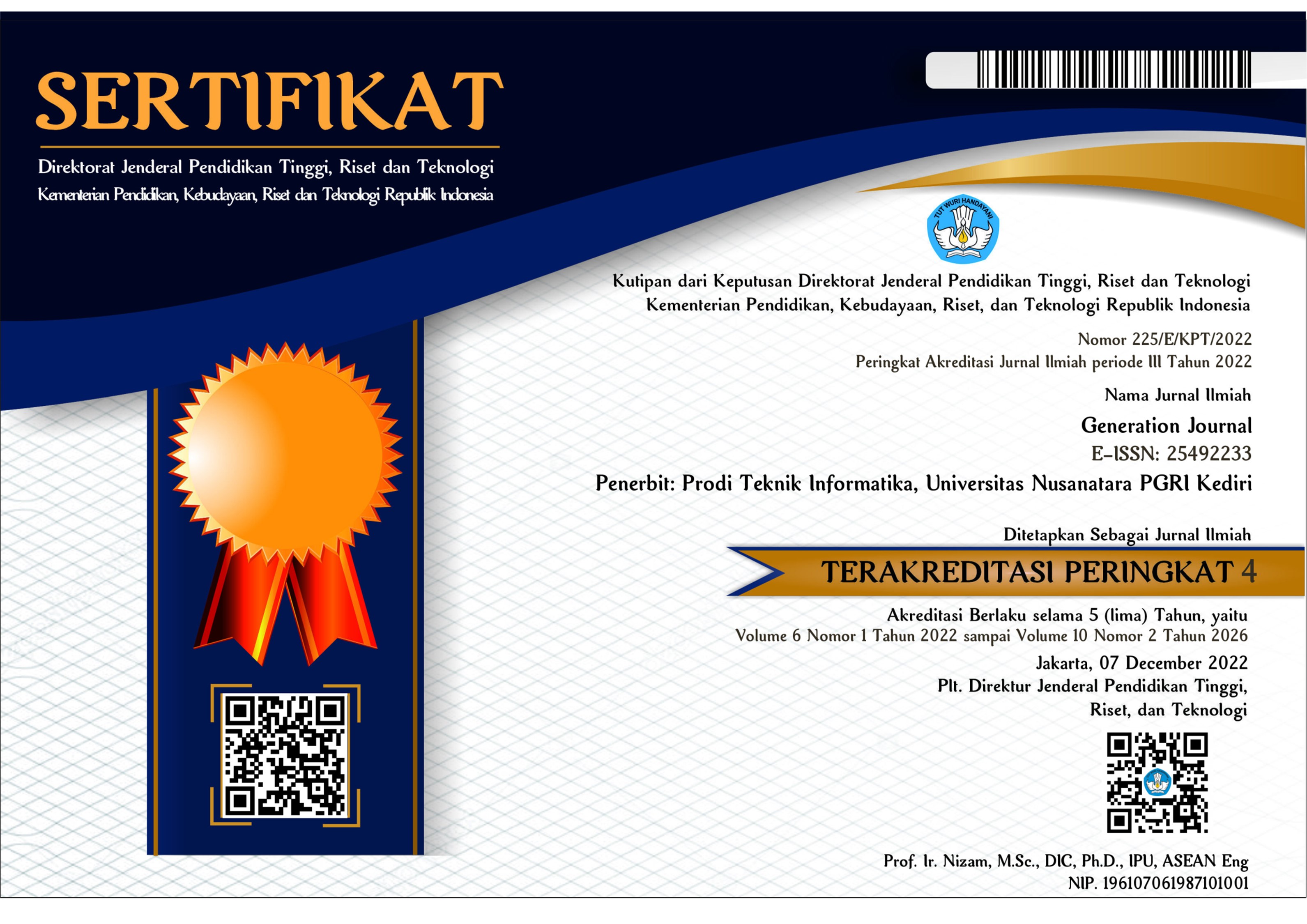Klasterisasi Kasus Kekerasan Terhadap Anak dan Perempuan Berdasarkan Algoritma K-Means
DOI:
https://doi.org/10.29407/gj.v5i2.15995Keywords:
Algortima K-Means, Clustering, Data Mining, Purity MeasureAbstract
Violence is action or threats against themselves alone, a group of people or community a group of people or community, loss psychologist, trauma, or deprivation of rights. District Karawang is on of the district that exist in the province of Jawa Barat. Violence that befell children and women in the area of Karawang bloom occurs, such as the lacj awareness of the victim to follow up cases that happened. The purpose of knowing the results of the cluster of cases of violence against children and women into three clusters are statterd in every sub-district in the District Karawang with category level of hardness low, medium or high in order that the government Karawang can provide treatment that is defferent and more targeted and focused on the results ot the analysis for each-each district. Data mining is the process of extracting data to obtain new information. In this study using CRIPS-DM methodology.Research is doing computation algorithm k-means clustering on the data of case of violence against children and women in 2016-2020. Results of testing using tools WEKA 3.8 earnded three cluster or the three categories of the level of violence that is cluster 0 there are 4 members who categorized the level of violence high, cluster 1 there are 2 members categorized the level of violence medium, and cluster 2 there are 24 members who categorized the level of violence low, the results of clustering is evaluated using equation testing purity measure, generate value purity 0,617, case that shows the cluster is quite good.
References
A. Anindya, Y. Indah, S. Dewi, and Z. D. Oentari, “Dampak Psikologis dan Upaya Penanggulangan Kekerasan Seksual Terhadap Perempuan,” Terap. Inform. Nusant., vol. 1, no. 3, pp. 137–140, 2020, [Online]. Available: https://ejurnal.seminar-id.com/index.php/tin/article/view/394.
F. Nuraeni, N. N. Febriani Sm, L. Listiani, and E. Rahmawati, “Implementation of K-Means Algorithm with Distance of Euclidean Proximity in Clustering Cases of Violence Against Women and Children,” 2019 1st Int. Conf. Cybern. Intell. Syst. ICORIS 2019, vol. 1, no. August, pp. 162–167, 2019, doi: 10.1109/ICORIS.2019.8874883.
E. S. B. Ningsih and S. Hennyati, “Kekerasan Seksual Pada Anak Di Kabupaten Karawang,” Midwife J., vol. 4, no. 02, pp. 56–65, 2018, [Online]. Available: http://jurnal.ibijabar.org/kekerasan-seksual-pada-anak-di-kabupaten-karawang/.
O. Bariah and R. Marlina, “Tinjauan Psikologi dan Agama Terhadap Tindak Kekerasan pada Anak,” J. Stud. Insa., vol. 7, no. 2, p. 92, 2019, doi: 10.18592/jsi.v7i2.2646.
D. Fitriani, H. Fajriah, and Erika Shovianda, “Gender Equality: Internasional Journal of Child and Gender Studies ISSN: 2461-1468/E-ISSN: 2548-1959,” J. Child Gend. Stud. ISSN, vol. 4, no. 1, pp. 39–54, 2018.
R. Singh, R. Reddy, V. Kapoor, and P. Churi, “K-means Clustering Analysis of Crimes on Indian Women K-means Clustering Analysis of Crimes on Indian Women,” no. August, 2020, doi: 10.5281/zenodo.3909955.
L. P. Refialy, H. Maitimu, and M. S. Pesulima, “Perbaikan Kinerja Clustering K-Means pada Data Ekonomi Nelayan dengan Perhitungan Sum of Square Error (SSE) dan Optimasi nilai K cluster,” Techno.Com, vol. 20, no. 2, pp. 321–329, 2021, doi: 10.33633/tc.v20i2.4572.
N. Putu, E. Merliana, and A. J. Santoso, “Analisa Penentuan Jumlah Cluster Terbaik pada Metode K-Means,” pp. 978–979.
T. Santoso and F. Saftarina, “Klasterisasi Petani Padi Sawah di Kota Metro Provinsi Lampung Menggunakan Algoritma K-Means Cluster dan Elbow Method,” J. Agribus. Community Empower., vol. 3, no. 1, pp. 37–43, 2020.
Iskandar, P. Tarigan, and saidi ramadan Siregar, “Penerapan Data Mining Dalam Surat Jalan Transportasi Mobil Angkutan Menggunakan Metode Cluestering,” J. Pelita Inform., vol. 17, pp. 460–464, 2018.
Y. P. Sari, A. Primajaya, and A. S. Y. Irawan, “Implementasi Algoritma K-Means untuk Clustering Penyebaran Tuberkulosis di Kabupaten Karawang,” INOVTEK Polbeng - Seri Inform., vol. 5, no. 2, p. 229, 2020, doi: 10.35314/isi.v5i2.1457.
I. Ismawati, “Kajian Data Mining Profil Siswa Baru Dalam Penentuan Strategi Promosi Dengan Metode Two Step Clustering,” J. Ilm. Teknol. Infomasi Terap., vol. 5, no. 3, pp. 47–59, 2019, doi: 10.33197/jitter.vol5.iss3.2019.302.
W. Supriyanti, Kusrini, and A. Amborowati, “Perbandingan Kinerja Algoritma c4.5 Dan Naive Bayes Untuk Ketepatan Pemilihan Konsentrasi Mahasiswa,” J. Inf. Politek. Indonusa, vol. 1, no. 3, pp. 61–67, 2016.
E. Muningsih and A. B. S. I. Yogyakarta, “Optimasi jumlah cluster k-means dengan metode elbow untuk pemetaan pelanggan,” Pros. Semin. Nas. ELINVO, no. September, pp. 105–114, 2017.
A. T. Rahman, Wiranto, and A. Rini, “Coal Trade Data Clustering Using K-Means (Case Study Pt. Global Bangkit Utama),” ITSMART J. Teknol. dan Inf., vol. 6, no. 1, pp. 24–31, 2017, [Online]. Available: https://jurnal.uns.ac.id/itsmart/article/download/11296/11108.
mohamad jajuli nurul rohmawati, sofi defiyanti, “Implementasi Algoritma K-Means Dalam Pengklasteran Mahasiswa Pelamar Beasiswa,” Jitter 2015, vol. I, no. 2, pp. 62–68, 2015.
S. Huber, H. Wiemer, D. Schneider, and S. Ihlenfeldt, “DMME: Data mining methodology for engineering applications - A holistic extension to the CRISP-DM model,” Procedia CIRP, vol. 79, pp. 403–408, 2019, doi: 10.1016/j.procir.2019.02.106.
S. E. D. A. Kusrini, “Algoritma K-Means untuk Diskretisasi Numerik Kontinyu Pada Klasifikasi Intrusion Detection System Menggunakan Naive Bayes,” Konf. Nas. Sist. Inform., pp. 61–66, 2017.
B. Juliartha, M. Putra, D. Ariani, and F. Yuniarti, “Analisis Hasil Belajar Mahasiswa Dengan Clustering Menggunakan Metode K-Means,” vol. 12, no. 2, pp. 49–58, 2020.
N. Anastasya, A. W. Widodo, and M. A. Rahman, “Pengelompokan Musik berdasarkan Emosi menggunakan Metode Transformasi Haar Wavelet,” J. Pengemb. …, vol. 3, no. 11, pp. 10524–10530, 2020, [Online]. Available: http://j-ptiik.ub.ac.id/index.php/j-ptiik/article/view/6706.
Downloads
Published
Issue
Section
License
Authors who publish with this journal agree to the following terms:
- Copyright on any article is retained by the author(s).
- The author grants the journal, the right of first publication with the work simultaneously licensed under a Creative Commons Attribution License that allows others to share the work with an acknowledgment of the work’s authorship and initial publication in this journal.
- Authors are able to enter into separate, additional contractual arrangements for the non-exclusive distribution of the journal’s published version of the work (e.g., post it to an institutional repository or publish it in a book), with an acknowledgment of its initial publication in this journal.
- Authors are permitted and encouraged to post their work online (e.g., in institutional repositories or on their website) prior to and during the submission process, as it can lead to productive exchanges, as well as earlier and greater citation of published work.
- The article and any associated published material is distributed under the Creative Commons Attribution-ShareAlike 4.0 International License














